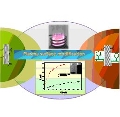Home > Press > Heavy Metal Free Environment with Plasma-Modified Carbon Nanotubes
 |
Abstract:
Carbon nanotubes are a fascinating type of carbon which have attracted enormous interest since their discovery only twenty years ago. With their high specific surface areas they offer ideal conditions for the removal of many kinds of organic and inorganic pollutants from various aqueous solutions.
Heavy Metal Free Environment with Plasma-Modified Carbon Nanotubes
Germany | Posted on June 1st, 2011Now, scientists at the Institute of Plasma Physics, CAS, have developed a way to modify multiwalled carbon nanotubes (MWCNTs) with macromolecular functional groups that significantly enhance their dispersion properties and adsorption capacities.
Using an environmentally friendly N2 plasma induced grafting technique, vinylpyridine was grafted on the MWCNT surfaces. The grafted vinylpyridine gives the MWCNTs high dispersion in aqueous solutions,and so the available functional groups of vinylpyridine form strong complexes with metal ions, and thereby enhances the adsorption of these ions onto the nanotubes. For example, looking at the adsorption capacity of Pb(II) ions, as an representative metal ion, the group's vinylpyridine grafted MWCNTs had a far higher higher adsorption capacity than any currently reported. This work highlights the application of plasma techniques not only in material science, but also in environmental pollution management. Through the grafting of special functional groups on nanomaterials by plasma technique, the nanomaterial can not only have high preconcentration and solidification of pollutants from large volumes of aqueous solutions, but also have a selectivity for different pollutant by grafting special functional groups.
Dr. Xiangke Wang of the Institute of Plasma Physics, CAS, China, leader of the team of researchers involved in this work, said: "This is a simple, environmentally friendly process to modify the properties of carbon nanotubes. The surface modified carbon nanotubes have high adsorption capacity in the removal of heavy metal ions and organic pollutants in environmental pollution cleanup."
####
For more information, please click here
Copyright © Wiley-VCH Materials Science Journals
If you have a comment, please Contact us.Issuers of news releases, not 7th Wave, Inc. or Nanotechnology Now, are solely responsible for the accuracy of the content.
| Related Links |
![]() X. Wang et al., Plasma Process. Polym., 2011 ; DOI: 10.1002/ppap.201000192
X. Wang et al., Plasma Process. Polym., 2011 ; DOI: 10.1002/ppap.201000192
| Related News Press |
News and information
![]() Researchers develop molecular qubits that communicate at telecom frequencies October 3rd, 2025
Researchers develop molecular qubits that communicate at telecom frequencies October 3rd, 2025
![]() Next-generation quantum communication October 3rd, 2025
Next-generation quantum communication October 3rd, 2025
![]() "Nanoreactor" cage uses visible light for catalytic and ultra-selective cross-cycloadditions October 3rd, 2025
"Nanoreactor" cage uses visible light for catalytic and ultra-selective cross-cycloadditions October 3rd, 2025
Nanotubes/Buckyballs/Fullerenes/Nanorods/Nanostrings
![]() Enhancing power factor of p- and n-type single-walled carbon nanotubes April 25th, 2025
Enhancing power factor of p- and n-type single-walled carbon nanotubes April 25th, 2025
![]() Chainmail-like material could be the future of armor: First 2D mechanically interlocked polymer exhibits exceptional flexibility and strength January 17th, 2025
Chainmail-like material could be the future of armor: First 2D mechanically interlocked polymer exhibits exceptional flexibility and strength January 17th, 2025
![]() Innovative biomimetic superhydrophobic coating combines repair and buffering properties for superior anti-erosion December 13th, 2024
Innovative biomimetic superhydrophobic coating combines repair and buffering properties for superior anti-erosion December 13th, 2024
Discoveries
![]() Researchers develop molecular qubits that communicate at telecom frequencies October 3rd, 2025
Researchers develop molecular qubits that communicate at telecom frequencies October 3rd, 2025
![]() Next-generation quantum communication October 3rd, 2025
Next-generation quantum communication October 3rd, 2025
![]() "Nanoreactor" cage uses visible light for catalytic and ultra-selective cross-cycloadditions October 3rd, 2025
"Nanoreactor" cage uses visible light for catalytic and ultra-selective cross-cycloadditions October 3rd, 2025
Announcements
![]() Rice membrane extracts lithium from brines with greater speed, less waste October 3rd, 2025
Rice membrane extracts lithium from brines with greater speed, less waste October 3rd, 2025
![]() Researchers develop molecular qubits that communicate at telecom frequencies October 3rd, 2025
Researchers develop molecular qubits that communicate at telecom frequencies October 3rd, 2025
![]() Next-generation quantum communication October 3rd, 2025
Next-generation quantum communication October 3rd, 2025
![]() "Nanoreactor" cage uses visible light for catalytic and ultra-selective cross-cycloadditions October 3rd, 2025
"Nanoreactor" cage uses visible light for catalytic and ultra-selective cross-cycloadditions October 3rd, 2025
Environment
![]() Researchers unveil a groundbreaking clay-based solution to capture carbon dioxide and combat climate change June 6th, 2025
Researchers unveil a groundbreaking clay-based solution to capture carbon dioxide and combat climate change June 6th, 2025
![]() Onion-like nanoparticles found in aircraft exhaust May 14th, 2025
Onion-like nanoparticles found in aircraft exhaust May 14th, 2025
![]() SMART researchers pioneer first-of-its-kind nanosensor for real-time iron detection in plants February 28th, 2025
SMART researchers pioneer first-of-its-kind nanosensor for real-time iron detection in plants February 28th, 2025
|
|
||
|
|
||
| The latest news from around the world, FREE | ||
|
|
||
|
|
||
| Premium Products | ||
|
|
||
|
Only the news you want to read!
Learn More |
||
|
|
||
|
Full-service, expert consulting
Learn More |
||
|
|
||








